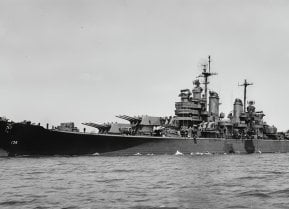Avro Vulcan: The Most Technically Advanced Design of the RAF’s V Bombers
The Avro Vulcan made her maiden flight on Aug. 30, 1952 and officially entered into RAF service in September 1956. She finally saw combat during the Falklands war.
Over a decade before Spock introduced legions of Star Trek fans to Planet Vulcan and its cerebral, philosophical humanoid beings, Britain’s Royal Air Force (RAF) had its own Vulcan, namely the Avro Vulcan.
The RAF’s iteration of the Vulcan wasn’t tasked with dropping leaflets exhorting recipients to “Live Long and Prosper.” It was designed with a rather more grim mission in mind: that of waging nuclear war against the Soviet Union in a doomsday scenario.
Avro Vulcan: Origins and Specifications
The Avro Vulcan made her maiden flight on Aug. 30, 1952 and officially entered into RAF service in September 1956.
The Vulcan was a jet-powered delta-wing strategic bomber, the second of the RAF’s so-called “V bombers” – the first being the Vickers Valiant and the third being the Handley Page Victor. These warbirds provided part of the United Kingdom’s nuclear deterrent force for 15 years, until the Royal Navy’s Polaris-class submarines assumed that morbid mantle in 1969.
As noted by the BAE Systems heritage page, “The design was considered the most technically advanced of the submissions in response to Air Ministry Specification B.35/46, although it was thought by some as the riskiest option.”
Indeed, the Air Ministry was so impressed that in 1958 they publicly proclaimed that, "At its operational height the Vulcan can outfly and outmanoeuvre any fighter in squadron service today." However, as the RAF Museum website points out, Soviet missile defenses had become so effective by 1966 that the Vulcans switched from high- to low-level penetration missions. They were completely withdrawn from the nuclear deterrent mission in 1970, switching over to a conventional bomber role in support of NATO forces in Europe.
The B.2 variant is the only version of the Vulcan to actually see combat. The plane had a fuselage length of 99 feet 11 inches, a wingspan of 111 feet, and a height of 27 feet 2 inches, with an empty weight of 83,573 pounds and a maximum takeoff weight of 250,000 pounds. Its maximum airspeed was 645 mph, with a cruising speed of 620 mph, or Mach-0.84. Its payload was initially either the Blue Danube or Red Beard nuclear gravity bomb, and this was later converted to a capacity for 21 1,000-pound conventional bombs. The plane carried no defensive armament.
Victorious Avro Vulcan: Combat-Tested
Needless to say, thanks to the collapse of the Soviet Union, the cataclysmic nuclear WWIII showdown never happened, But the Vulcan did see combat.
The plane made a significant contribution to Great Britain’s victory over Argentina in the 1982 Falklands War (or as the Argentines prefer to call it, La Guerra de las Malvinas).
The specific phase of the Falklands campaign was named Operation Black Buck, and for 19 years the mission held the record for longest combat bombing raid in military history, at 6,600 nautical miles and 16 hours’ flight time for the round trip. (The record was finally broken by the B-2 Spirit “Stealth Bomber” during Operation Enduring Freedom in 2001.)
Operation Black Buck took place in seven phases. The objective was to attack Port Stanley Airport and hit its runway, operational facilities, and radar sites. The first phase took place on April 30, 1982, when two Avro Vulcans – supported by 22 Victors serving a midair refueling role – departed from RAF Ascension Island. One of the V bombers had to return to base due to a cabin pressurization failure, leaving then-Flight Lt. Withers and his four-man crew on an inadvertent single-ship mission.
After a harrowing trip through an electrical storm, the plane arrived over the target, releasing its 21 bombs, 16 of which detonated. Only one of the bombs made a direct hit on the airstrip, but that lone hit had a meaningful impact.
In Withers’ own words:
“We managed to put a bomb on the runway, which meant the Argentines could not use that runway for their aircraft to land and refuel if they wanted to attack our ships…It certainly was very strange to be going in on the first attack very sorta cold-bloodedly...Ours was the first attack of the conflict.” After egressing and reaching the final rendezvous point before returning home, Withers described the sight of that last Vulcan refueler as “the most beautiful sight in the world.”

The 007 Connection
The Avro Vulcan also had her fictitious cinematic moment in the sun, thanks to The World’s Most Famous Secret Agent: in 1965’s Thunderball, the fourth film in the James Bond series, the primary villain, Emilio – SPECTRE’s Number Two man after Ernst Stavro Blofeld – orchestrates the hijacking of a Vulcan for its nuclear payload.

Where Are They Now?
The Vulcan was retired in 1984. Out of 134 production models assembled, 19 survivors remain, spread out among museums in the U.S, Canada, and the UK. Stateside, you can see them at the Strategic Air Command & Aerospace Museum in Ashland, Nebraska; the Castle Air Museum in Atwater, California; and the Barksdale Global Power Museum at Barksdale AFB, Louisiana.

About the Author
Christian D. Orr is a former Air Force Security Forces officer, Federal law enforcement officer, and private military contractor (with assignments worked in Iraq, the United Arab Emirates, Kosovo, Japan, Germany, and the Pentagon). Chris holds a B.A. in International Relations from the University of Southern California (USC) and an M.A. in Intelligence Studies (concentration in Terrorism Studies) from American Military University (AMU). He has also been published in The Daily Torch and The Journal of Intelligence and Cyber Security. Last but not least, he is a Companion of the Order of the Naval Order of the United States (NOUS). In his spare time, he enjoys shooting, dining out, cigars, Irish and British pubs, travel, USC Trojans college football, and Washington DC professional sports.


